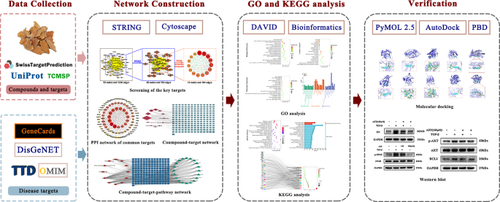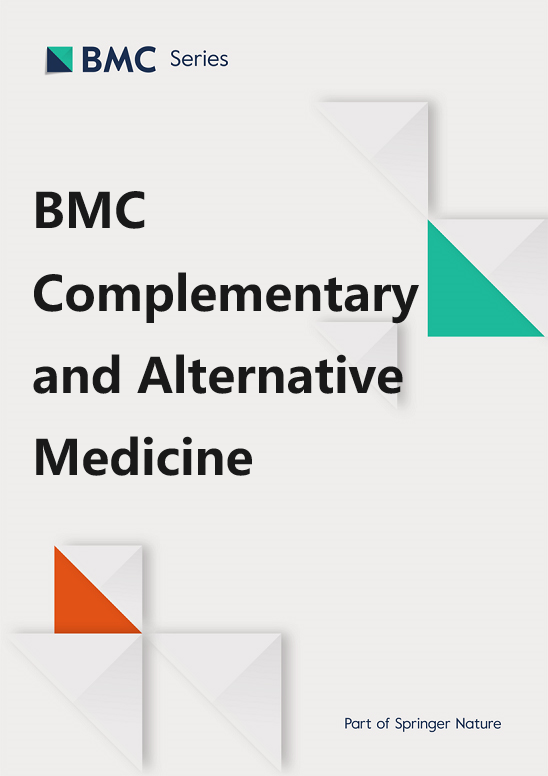Mechanism of Smilax china L. in the treatment of intrauterine adhesions based on network pharmacology, molecular docking and experimental validation
IF 3.4
2区 医学
Q1 Medicine
引用次数: 0
Abstract
Smilax china L. (SCL) is a traditional herbal medicine for the potential treatment of intrauterine adhesion (IUA). However, the mechanisms of action have not yet been determined. In this study, we explored the effects and mechanisms of SCL in IUA by network pharmacology, molecular docking and molecular biology experiments. Active ingredients and targets of SCL were acquired from TCMSP and SwissTargetPrediction. IUA-related targets were collected from the GeneCards, DisGeNET, OMIM and TTD databases. A protein‒protein interaction (PPI) network was constructed by Cytoscape 3.9.1 and analysed with CytoHubba and CytoNCA to identify the core targets. The DAVID tool was used for GO and KEGG enrichment analyses. Furthermore, molecular docking was employed to assess the interaction between the compounds and key targets. Finally, the mechanisms and targets of SCL in IUA were verified by cellular experiments and western blot. A total of 196 targets of SCL were identified, among which 93 were related to IUA. Topological and KEGG analyses results identified 15 core targets that were involved in multiple pathways, such as inflammation, apoptosis, and PI3K/AKT signalling pathways. Molecular docking results showed that the active compounds had good binding to the core targets. In vitro experiments showed that astilbin (AST), a major component of SCL, significantly reduced TGF-β-induced overexpression of fibronectin (FN), activation of the PI3K/AKT signalling pathway and the expression of downstream factors (NF-κB and BCL2) in human endometrial stromal cells, suggesting that AST ameliorates IUA by mediating the PI3K/AKT/NF-κB and BCL2 proteins. AST, a major component of SCL, may be a potential therapeutic agent for IUA. Moreover, its mechanism is strongly associated with regulation of the PI3K/AKT signalling pathway and the downstream NF-κB and BCL2 proteins. This study will provide new strategies that utilize AST for the treatment of IUA.

基于网络药理学、分子对接和实验验证的Smilax china L.治疗宫腔内粘连的机制
Smilax china L.(SCL)是一种传统草药,可用于治疗宫腔内粘连(IUA)。然而,其作用机制尚未确定。在本研究中,我们通过网络药理学、分子对接和分子生物学实验探索了SCL对IUA的作用和机制。SCL 的有效成分和靶点来自 TCMSP 和 SwissTargetPrediction。IUA相关靶标来自GeneCards、DisGeNET、OMIM和TTD数据库。用 Cytoscape 3.9.1 构建了蛋白质-蛋白质相互作用(PPI)网络,并用 CytoHubba 和 CytoNCA 进行分析,以确定核心靶标。DAVID 工具用于 GO 和 KEGG 富集分析。此外,还采用了分子对接技术来评估化合物与关键靶点之间的相互作用。最后,通过细胞实验和Western blot验证了SCL在IUA中的作用机制和靶点。共鉴定出196个SCL靶点,其中93个与IUA相关。拓扑和KEGG分析结果表明,有15个核心靶点涉及多个通路,如炎症、细胞凋亡和PI3K/AKT信号通路。分子对接结果显示,活性化合物与核心靶点结合良好。体外实验表明,SCL的主要成分Astilbin(AST)能显著降低TGF-β诱导的人子宫内膜基质细胞中纤维连接蛋白(FN)的过表达、PI3K/AKT信号通路的激活以及下游因子(NF-κB和BCL2)的表达,这表明AST能通过介导PI3K/AKT/NF-κB和BCL2蛋白来改善IUA。作为 SCL 的主要成分,AST 可能是 IUA 的潜在治疗药物。此外,其机制与 PI3K/AKT 信号通路及下游 NF-κB 和 BCL2 蛋白的调节密切相关。这项研究将为利用 AST 治疗 IUA 提供新的策略。
本文章由计算机程序翻译,如有差异,请以英文原文为准。
求助全文
约1分钟内获得全文
求助全文
来源期刊

BMC Complementary and Alternative Medicine
INTEGRATIVE & COMPLEMENTARY MEDICINE-
CiteScore
7.00
自引率
0.00%
发文量
0
审稿时长
3 months
期刊介绍:
BMC Complementary Medicine and Therapies is an open access journal publishing original peer-reviewed research articles on interventions and resources that complement or replace conventional therapies, with a specific emphasis on research that explores the biological mechanisms of action, as well as their efficacy, safety, costs, patterns of use and/or implementation.
 求助内容:
求助内容: 应助结果提醒方式:
应助结果提醒方式:


